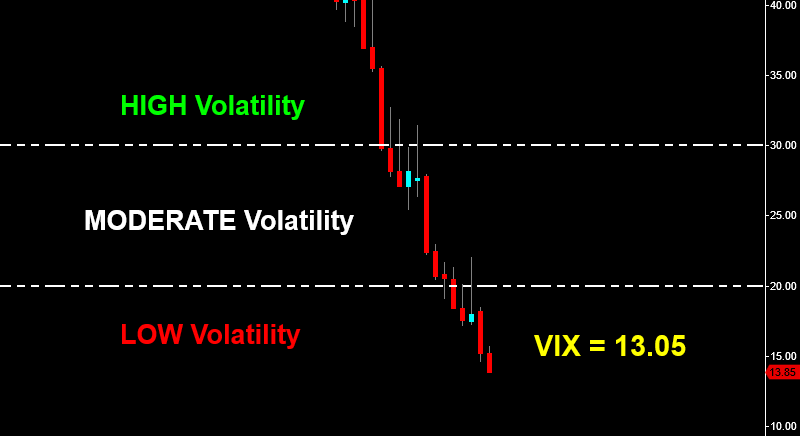Navigating the Calm Before the Storm: Anticipating Earnings Season
By:
Iftekhar (Ifty) Khan
On
26/06/2024Reading time:
2 min
Summary:
As traders and investors, understanding market behavior around earnings season can provide valuable insights and opportunities. With the second quarter drawing to a close, we are on the cusp of another earnings season, typically a period marked by significant market activity and volatility. In this blog, we'll explore why markets often seem slow leading up to earnings announcements, what to expect during earnings season, how to prepare, and the current gauge of market volatility, including a look at the VIX.

VIX: Fear gauge
Why Do Markets Slow Down Before Earnings?
Investor Caution: As the anticipation builds for quarterly earnings reports, many investors adopt a "wait-and-see" approach. This cautious stance is understandable, given that earnings announcements can significantly impact stock prices. By holding off on large trades, investors aim to avoid the risk associated with potential earnings surprises. For instance, a company’s earnings miss or lowered guidance can lead to sharp declines, whereas a positive surprise can drive up the stock price significantly.
Uncertainty: Earnings season brings updates on a company's financial health, performance, and future outlook. This influx of information introduces a high degree of uncertainty, leading to reduced trading activity as market participants await clarity. Companies may report higher-than-expected revenues, unexpected losses, or new strategic initiatives, all of which can shift investor sentiment.
Volatility Concerns: Known for triggering sharp price movements, earnings reports can lead to increased market volatility. To mitigate exposure to sudden price swings, some traders prefer to stay on the sidelines until the reports are released. This behavior can result in temporarily reduced trading volumes and narrower market movements.
Sector Focus: Leading up to earnings season, attention often shifts to specific sectors or companies expected to report significant earnings. This focused interest can divert trading volume away from other parts of the market, contributing to an overall slowdown. For example, during tech earnings week, investors might be more focused on companies like Apple, Google, and Amazon, causing reduced activity in other sectors.
Additional Factors Contributing to Current Low Volatility
The financial markets can experience periods of low volatility for a variety of reasons. Here are a few factors that might be contributing to the current sluggishness:
Seasonal Effects: Financial markets often experience reduced volatility during certain times of the year. For example, the summer months and the holiday season can lead to lower trading volumes as traders and investors take vacations, leading to less market activity.
Economic Stability: When economic indicators show stability and there are no major surprises from economic data, markets tend to be calmer. If the global economy is stable with predictable growth, inflation, and employment figures, traders might not see the need for significant adjustments to their portfolios.
Central Bank Policies: Central banks play a crucial role in influencing market volatility. If central banks are adopting a wait-and-see approach or have communicated their policies clearly, markets may experience lower volatility. Predictable monetary policies reduce uncertainty and speculative trading.
Geopolitical Calm: Geopolitical events often spark volatility as traders react to uncertainties and potential risks. A period without significant geopolitical tensions can contribute to market tranquility.
Market Sentiment: Market participants' sentiment can influence volatility. If traders and investors are generally optimistic or pessimistic but without extreme emotions, markets may move within a narrower range.
Low Interest Rates: Extended periods of low interest rates can lead to a hunt for yield in more stable investments, reducing volatility in more traditional asset classes.
Market Maturity: As financial markets mature, they often experience lower volatility. Innovations, technology, and regulations have led to more efficient markets, reducing erratic price movements.
In summary, a combination of seasonal effects, economic stability, clear central bank policies, geopolitical calm, and overall market sentiment can contribute to the current low volatility in financial markets. Just like the weather, market conditions fluctuate, and this calm period might be the market's way of taking a breather before the next storm. So, enjoy the calm while it lasts, but always keep an umbrella handy just in case!
The Quarterly Earnings Cycle
Earnings announcements typically follow a quarterly schedule, with most companies reporting their financial results a few weeks after the end of each fiscal quarter. Here's a general timeline for when these earnings seasons occur:
Q1 Earnings: Mid-April to mid-May (for the quarter ending March 31)
Q2 Earnings: Mid-July to mid-August (for the quarter ending June 30)
Q3 Earnings: Mid-October to mid-November (for the quarter ending September 30)
Q4 Earnings: Mid-January to mid-February (for the quarter ending December 31)
Given the current timing, we are approaching the Q2 earnings season, which will commence in mid-July 2024. This period is crucial for traders and investors as it provides insights into the performance of companies during the second quarter of the year. For example, investors will be keen to see how companies have managed costs, dealt with supply chain disruptions, or capitalised on new market opportunities.
Gauging Market Volatility: The Role of the VIX
One of the key tools for measuring market volatility is the CBOE Volatility Index (VIX), often referred to as the "fear gauge." The VIX reflects the market's expectations for volatility over the next 30 days, derived from the prices of S&P 500 index options. When the VIX is high, it indicates that investors anticipate significant market fluctuations; conversely, a low VIX suggests expectations of relative market stability.
As of now, the VIX is at 13.9, indicating that the market is expecting relatively low volatility in the near term. A VIX level of 13.9 is quite low, suggesting that investors are not anticipating large market swings. Here’s what this could mean:
Investor Confidence: The low VIX level implies that investors are relatively confident about the market's short-term stability. They do not foresee major disruptions or significant price swings. This can be due to positive economic data, strong corporate earnings forecasts, or geopolitical stability.
Calm Before the Storm?: Historically, very low VIX levels can sometimes precede periods of increased volatility. Investors may become too complacent, potentially leading to sharp reactions to unexpected news or events. For example, a sudden geopolitical event or unexpected economic data release could quickly change market dynamics.
Good Time for Strategic Planning: For traders and investors, a low VIX environment can be a good time to review and adjust portfolios, make strategic investments, and prepare for potential future volatility. Consider evaluating your portfolio's exposure to various sectors and ensuring it aligns with your risk tolerance and investment goals.
Option Pricing: Lower VIX levels generally result in lower premiums for options, as these reflect the market's lower expectations for price swings. This can make options strategies more attractive from a cost perspective. For example, buying call or put options might be less expensive, allowing for strategic positioning ahead of expected volatility.
Preparing for Earnings Season
To effectively navigate the upcoming earnings season, consider the following strategies:
Stay Informed: Use financial news platforms such as Yahoo Finance, MarketWatch, and Bloomberg to track earnings calendars and stay updated on key dates. These resources provide comprehensive lists of upcoming earnings reports and can help you plan your trading strategy. For instance, you can look up the earnings release dates for companies in your portfolio and anticipate market reactions.
Research and Analysis: Prioritize researching the companies and sectors you are interested in. Understanding the historical performance, analyst expectations, and recent developments can give you an edge in anticipating market reactions. For example, reviewing a company's past earnings surprises and guidance updates can help you gauge potential market moves.
Diversify Your Portfolio: To mitigate the risk of volatility, consider diversifying your investments across different sectors and asset classes. This approach can help cushion the impact of any single company's earnings surprise. For instance, balancing tech stocks with consumer staples or healthcare can reduce portfolio volatility.
Set Clear Objectives: Define your trading goals and risk tolerance before entering earnings season. Having a clear plan can help you stay disciplined and make informed decisions amidst the market fluctuations. For example, setting stop-loss orders or target prices can protect your investments and lock in gains.
Use Caution with Options: Options can be a powerful tool during earnings season, but they come with their own set of risks. If you choose to trade options, ensure you have a solid understanding of the strategies and potential outcomes. For example, strategies like straddles or strangles can benefit from increased volatility but require careful management.
Conclusion
Earnings season is an exciting and often unpredictable period in the financial markets. While the lead-up to earnings reports may feel like the calm before the storm, it's an excellent time to prepare and position yourself for the opportunities ahead. By staying informed, conducting thorough research, and maintaining a disciplined approach, you can navigate earnings season with confidence and potentially capitalize on the market movements that follow.
Just like the weather, market conditions fluctuate, and this calm period might be the market's way of taking a breather before the next storm. So, enjoy the calm while it lasts, but always keep an umbrella handy just in case!
Feel free to reach out to CLiK Trading Education if you have any questions or need further guidance on navigating the financial markets. We're here to help you succeed!
